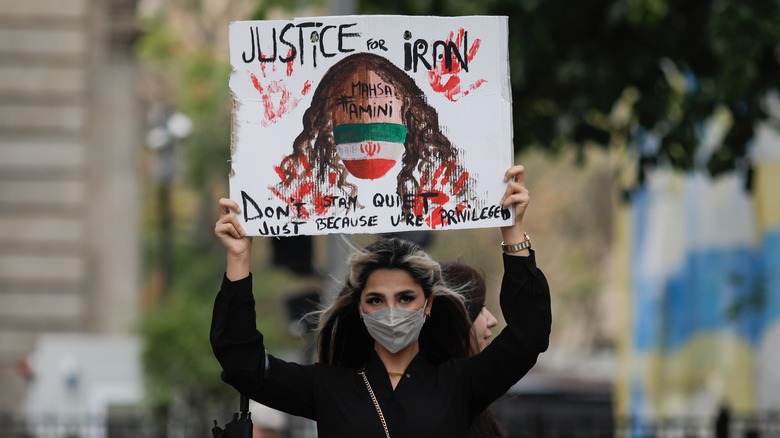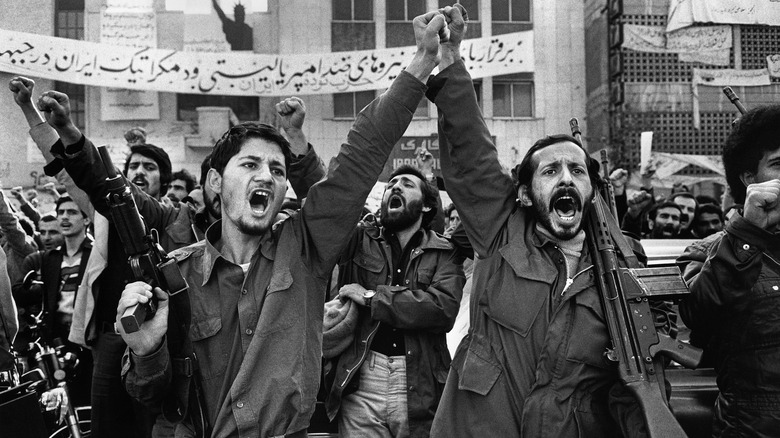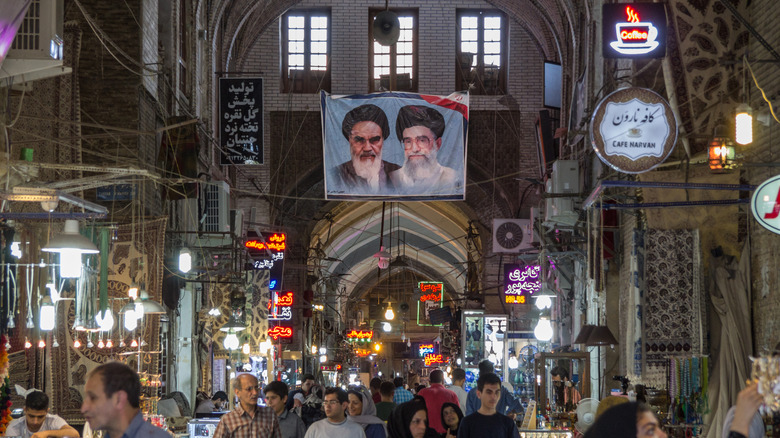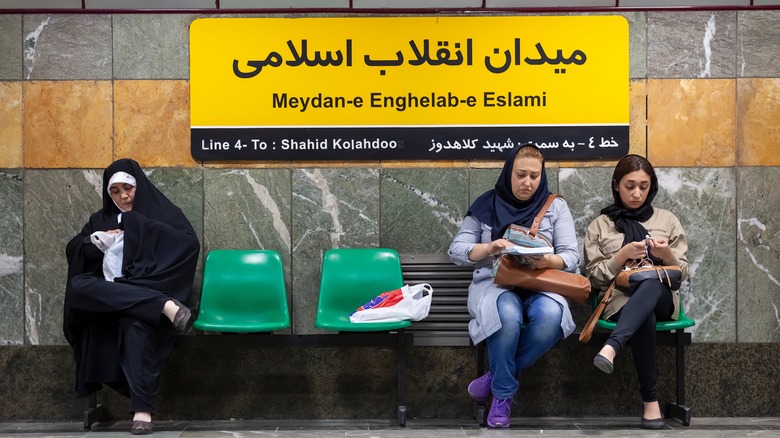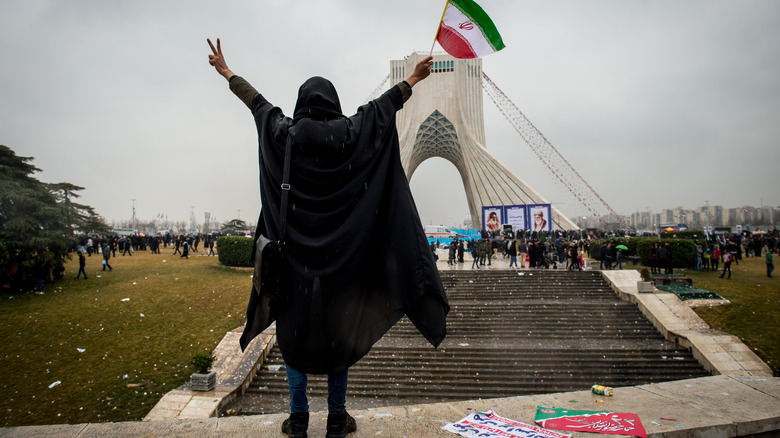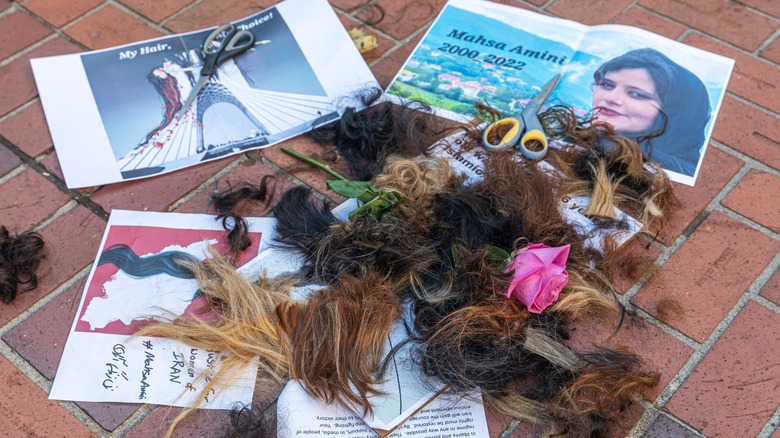How Iran's Islamic Revolution Changed The Country Forever
Time and time again history shows us that the goals of governments often stand at odds with the desires of people. Even as democratic states arose in the 20th century, the century saw an equal and opposing pushback in the form of political dictators and religious fanatics, as the Institut für Zeitgeschichte outlines. Worst-case scenarios produced mass-murdering madmen like Joseph Stalin in the USSR, Adolf Hitler in Germany, Mao Zedong in China, and Pol Pot in Cambodia. Such tyrants appeared in the public sphere preaching salvation. But even less severe regimes produced hardship, suffering, and death. They still do.
Such is the case with Iran, a modern nation caught between two versions of itself, and which began the 20th century caught between two powers: Russia and the U.K. In the early 1900s the "Great Game" of international maneuvers settled on countries like Iran and Afghanistan, per the U.S. Library of Congress. NYU's Grey Art Gallery tells us the U.K. and Russia operated in opposing spheres of power in Iran. At the same time internal struggles between politicians, clergy, students, and more left the nation broken come 1921.
By 1941, the Pahlavi dynasty came to power and set about rapidly modernizing Iran's infrastructure, education, and social norms. Progress surged, and Westernization happened fast — too fast for some. Iranian conservatives took issue with their country's direction and revolted. The country's 1979 Islamic Revolution undid decades of progress, gave some people what they wanted, and the vast majority what they didn't.
An obliteration of liberal progress
To understand how radical of a change Iran underwent in 1979, we need not look any further than photos from Iranian '70s fashion magazines. Women stand in provocative poses or wear stylized, runway-like fashion, both of which are impossible in Iran's current, religiously conservative state. Other pictures show a family lounging at a picnic in a park, a group of friends browsing platform shoes, and women leaning over a lab table at Tehran University doing some work. Especially when considering Iran's current, mandatory head-to-toe clothing coverings for women, these glimpses from Iran's past look like they've swapped places with Iran's present.
But in a way, that was the goal of the Islamic Revolution. The Sigma Iota Rho (SIR) Journal of International Relations describes an anti-Western sentiment that grew in Iran starting about 1977. Like the Turkish leader Kemal Atatürk before him, the Swiss-educated Iranian Shah Muhammad Reza Pahlavi had a love of all things Western and had steered his country in the direction of a progressive, liberal, democratized state after coming to power in 1941. This affected Iranian women more than anyone, as they gained the right to initiate divorce, retain custody of children, pursue whatever subject of education they wanted, wear what they wanted, hold government office and positions in business, and more. And yet, Insider says that Pahlavi's grip on power was tenuous, and all his efforts soon collapsed.
[Featured image via Wikimedia Commons | Cropped and scaled]
A shift to Shiite-led power
Twenty-five years is a short time for a society to undergo rapid change, which was exactly the case with Iran in the middle of the 20th century. Traditionalists took issue with the direction their country moved during Shah Muhammad Reza Pahlavi's reign. As Insider says, they were particular bothered by the relaxed attitude towards women's clothing. Pahlavi might have exacerbated the issue when he banned religious veils entirely, which didn't give those who wanted to wear one the choice to do so.
Even though we typically date the Iranian Islamic Revolution to 1979, the whole thing was more of a series of riots, protests, and rebellions that happened from 1977 to 1979, as the International Center on Nonviolent Conflict explains. Various populist groups, including Marxists, liberals who wanted a full constitutional republic, and mullahs (Islamic clergy) all vied to take power from the government, which at that time was technically a monarchy of the Pahlavi dynasty. All these groups felt, despite the freedoms afforded them, that they were living under a dictatorship of a different name. They also took issue with what they saw as governmental corruption and opulence.
In the end, Pahlavi fled the country, and the previously exiled, high-ranking religious leader Ayatollah Ruhollah Khomeini took power. Khomeini was Shiite Muslim rather than Sunni Muslim, part of a globally Muslim minority group who typically abide by stricter thinking regarding the lineage of the prophet Muhammad and interpretation of the Quran, per Insider.
Slow gains over a long time
Iran's 1979 Islamic Revolution rolled back the country's previous 35-plus years of state-over-religion policymaking. It also produced some strangely paradoxical improvements — albeit on a limited scale — at great cost, and over decades. Once again, we're speaking mostly of women's rights. In the immediate years following the revolution, women's roles reverted to near-enslaved status: They could no longer initiate divorce, they did not retain child custody, their daily movements were dictated by their husbands, they were banned from 78 subjects at university because of "biological reasoning," and more, as The Sigma Iota Rho (SIR) Journal of International Relations describes.
And yet, bizarrely enough, starting with this "Cultural Revolution" — as it was called — literacy rates for women skyrocketed from 35.48% in 1976 to 74.2% in 1996, almost equal to men. Similarly, despite the overall reduction in quality of education at universities and severe limitations imposed on subjects available to women, the Middle East Institute shows that by 2007 women outnumbered men in every higher education field except engineering — including medicine, agriculture, humanities, the arts, and more.
Such improvements and changes weren't necessarily due to public, governmental policy resulting from the Islamic Revolution, however. As recent discontent amongst Iran's women population indicates, such improvements might have happened simply because Iranian women got fed up with societal restrictions and decided to push back in whatever ways possible. Pictures of very loose, literally pushed-back head scarves from 2005 show precisely as much.
A long, proud history
The year 2019 was the 40th anniversary of Iran's Islamic Revolution, a revolution that's left the nation riddled with cultural contradictions that strain relationships between its people and its government. Iran's official name is the Islamic Republic of Iran, a name alluding to the subordinate nature of civil law to religious ideology, one where people "have a role in the society but within an Islamic framework," Iranian author Haleh Esfandiari a told the The Sigma Iota Rho (SIR) Journal of International Relations. Reality is far more harsh than this explanation implies, however. With so much power consolidated into the country's religious elites, PBS explains that Iran is a dictatorial theocracy where rights are greatly curtailed in comparison to the decades leading up to 1979's revolution.
The U.S. Department of State calls the Iranian government a "dangerous regime" but points out that this threat derives from said government and not the nation's people. Even though Iran's leadership remains vehemently anti-West, the Migration Policy Institute says that the U.S. is the most common destination worldwide for Iranian emigrants, followed by Canada, Germany, and the U.K. Twenty-three percent of those who've emigrated to the U.S. arrived 2010 or later. Iran also differs from its neighbors in history and language. It's comprised of a millennia-old, unique ethnic group spanning back to the Persian Empire circa 550 B.C.E. Its people also speak Farsi, aka Persian, rather than Arabic like neighboring countries. Such a proud cultural heritage only fuels the desire of many Iranians to rebel against authorities.
Blood for hair and clothing
Iranian people have learned to live as unobstructed as possible. At the same time, decades of simmering resentment came to a gruesome, tragic head in 2022 with the death of a young woman who came to represent the struggles of Iranian women in particular, and on the whole: 22-year-old Mahsa Amini, who was visiting Tehran to see her brother.
On September 13, Amini got arrested by Iran's "morality police," who NPR says prowl the streets checking for offensive hair, clothing, and more. Men might get stopped for having unkempt beards. Women might get stopped for too much hair peeking out from veils, or for walking with boyfriends. Amini died in police custody. Iran International reports that her lungs were full of blood and her brain crushed from "multiple blows to the head." Surgical intervention was impossible. When photos of her in a hospital bed got out, NPR says that riots ran rampant and women burned their hijabs by the score. Iranians across the world joined in.
Rather than come to their senses, Al-Monitor reports that the Iranian government doubled down. Removing a headscarf in public can now land a woman in prison for up to 10 years, on top of being banned from work and having property confiscated. RadioFreeEurope says that the Iranian government also plans to install surveillance cameras in public spaces to identify offenders.
